- Photo Safaris
- Alaska Bears & Puffins World's best Alaskan Coastal Brown Bear photo experience. Small group size, idyllic location, deluxe lodging, and Puffins!
- Participant Guestbook & Testimonials Candid Feedback from our participants over the years from our photo safaris, tours and workshops. We don't think there is any better way to evaluate a possible trip or workshop than to find out what others thought.
- Custom Photo Tours, Safaris and Personal Instruction Over the years we've found that many of our clients & friends want to participate in one of our trips but the dates we've scheduled just don't work for them or they'd like a customized trip for their family or friends.
- Myanmar (Burma) Photo Tour Myanmar (Burma) Photo Tour December 2017 -- with Angkor Wat option
- Reviews Go hands-on
- Camera Reviews Hands-on with our favorite cameras
- Lens reviews Lenses tested
- Photo Accessories Reviews Reviews of useful Photo and Camera Accessories of interest to our readers
- Useful Tools & Gadgets Handy tools and gadgets we've found useful or essential in our work and want to share with you.
- What's In My Camera Bag The gear David Cardinal shoots with in the field and recommends, including bags and tools, and why
- Articles About photography
- Getting Started Some photography basics
- Travel photography lesson 1: Learning your camera Top skills you should learn before heading off on a trip
- Choosing a Colorspace Picking the right colorspace is essential for a proper workflow. We walk you through your options.
- Understanding Dynamic Range Understanding Dynamic Range
- Landscape Photography Tips from Yosemite Landscape Photography, It's All About Contrast
- Introduction to Shooting Raw Introduction to Raw Files and Raw Conversion by Dave Ryan
- Using Curves by Mike Russell Using Curves
- Copyright Registration Made Easy Copyright Registration Made Easy
- Guide to Image Resizing A Photographers' Guide to Image Resizing
- CCD Cleaning by Moose Peterson CCD Cleaning by Moose Peterson
- Profiling Your Printer Profiling Your Printer
- White Balance by Moose Peterson White Balance -- Are You RGB Savvy by Moose Peterson
- Photo Tips and Techniques Quick tips and pro tricks and techniques to rapidly improve your photography
- News Photo industry and related news and reviews from around the Internet, including from dpreview and CNET
- Getting Started Some photography basics
- Resources On the web
- My Camera Bag--What I Shoot With and Why The photo gear, travel equipment, clothing, bags and accessories that I shoot with and use and why.
- Datacolor Experts Blog Color gurus, including our own David Cardinal
- Amazon Affiliate Purchases made through this link help support our site and cost you absolutely nothing. Give it a try!
- Forums User to user
- Think Tank Photo Bags Intelligently designed photo bags that I love & rely on!
- Rent Lenses & Cameras Borrowlenses does a great job of providing timely services at a great price.
- Travel Insurance With the high cost of trips and possibility of medical issues abroad trip insurance is a must for peace of mind for overseas trips in particular.
- Moose Peterson's Site There isn't much that Moose doesn't know about nature and wildlife photography. You can't learn from anyone better.
- Journeys Unforgettable Africa Journeys Unforgettable -- Awesome African safari organizers. Let them know we sent you!
- Agoda International discounted hotel booking through Agoda
- Cardinal Photo Products on Zazzle A fun selection of great gift products made from a few of our favorite images.
- David Tobie's Gallery Innovative & creative art from the guy who knows more about color than nearly anyone else
- Galleries Our favorite images
New value-price wildlife lens champion: Tamron 150-600mm zoom field-tested
New value-price wildlife lens champion: Tamron 150-600mm zoom field-tested
Submitted by David Cardinal on Wed, 05/20/2015 - 16:01
 Wildlife photographers have some amazing, and amazingly expensive, lens options from Canon and Nikon, but for many the huge price tags – not to mention large size and weight -- make them impractical. Instead, they have needed to compromise image quality to meet their budget. Fortunately, modern manufacturing techniques and lens design software improvements have continued to improve the quality of third-party value-priced lenses. The first of this new breed is the Tamron 150-600mm lens that I field tested in Texas during my workshops this month...
Wildlife photographers have some amazing, and amazingly expensive, lens options from Canon and Nikon, but for many the huge price tags – not to mention large size and weight -- make them impractical. Instead, they have needed to compromise image quality to meet their budget. Fortunately, modern manufacturing techniques and lens design software improvements have continued to improve the quality of third-party value-priced lenses. The first of this new breed is the Tamron 150-600mm lens that I field tested in Texas during my workshops this month...
I was pleasantly surprised by both its image quality and focus speed. I plan to review Sigma’s very similar model, but for now I wanted to pass along my thoughts on the exciting new Tamron…
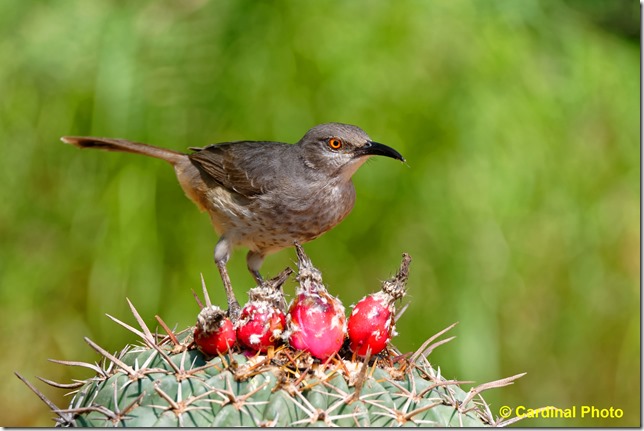
The Tamron provides excellent image quality for a value-priced lens,
as shown by this Curve-billed Thrasher eating cactus fruit image from our Rio Grande Valley photo safari.
Plenty sharp, even out to 600mm
I expected to see some image quality loss at the long end of this lens, and perhaps even cramp my shooting style to avoid it, but I didn’t have to. I could push the lens out to 600mm and take professional-grade images (some of which are showcased in this review). Often when I review value-priced lenses while I’m on a safari, I feel the need to go back to my “pro” lenses to get real work done. In this case, I left my Nikon 200-400mm f/4 in my camera bag for most of the two weeks, and was quite happy with my results using the additional reach of the Tamron (without needing to add and remove a teleconverter all the time). Now, the problem with reviewing value lenses is that purists always get bent out of shape because, after all, the $1070 super-zoom is NOT as sharp as the $12,000 600mm f/4. Okay, no it is not. Duh! That’s not the point. The point is that if you can get close enough for most people for 1/10th the price, and less than half the weight. If you’re in doubt, then you may want to rent one first and decide for yourself.
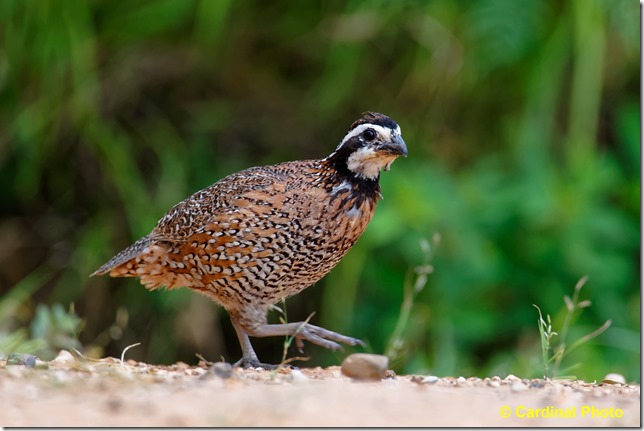
This Bobwhite was captured at 600mm. It is what I’d call “acceptably” sharp, although of course
not as tack sharp as with a (much more expensive) 600mm f/4 prime lens.
It is hard to get detailed data comparing the Tamron 150-600mm lens to other lenses as the category is so new. So I put together a comparison with the old-version Canon 100-400, and the new version Nikon 80-400. The Tamron falls in between the two. It’s overall rating is reduced a bit because it is evaluated out to 500mm. If measured only out to 400mm, it would score even better. I would have used the new version of the Canon, but it hasn’t been benchmarked yet:
Surprisingly-fast focus speed – out to almost 400mm
For most of its focus range, the built-in focus motors, combined with a modern DSLR’s focusing software, provide very quick focusing. As you move past about 350 to 400mm out to 600mm, the variable aperture of the lens shifts past the magic f/5.6 to f/6 and eventually f/6.3, and the lens focuses noticeably more slowly. It is still reasonable for most applications, but in situations where you need very quick focus, keeping the lens zoomed out until the aperture can be set to f/5.6 is really helpful. Note that you don’t have to set the exposure to f/5.6, becauses lenses always focus using their maximum aperture, but you do need to be at a focal length that makes f/5.6 possible.
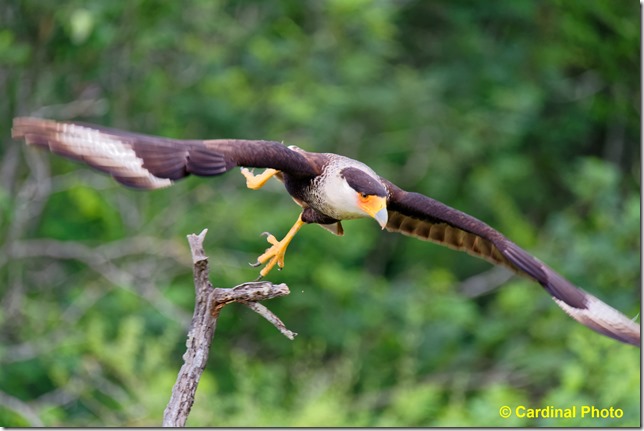
Even at 600mm, the Tamron focused fast enough when used with my Nikon D810 to capture
this Crested Caracara as it took off from its perch.
Photo from our Rio Grande Valley Photo Safari.
Excellent Image Stabilization (aka Vibration Reduction)
The Vibration Compensation (VC, as Tamron calls it, or VR for Nikon, or IS for Canon) technology in the lens performed amazingly well for a lens of this focal range and price. I was able to hand-hold shots at 1/60s, even out at 600mm, and get sharp images. That’s a large plus, especially since this lens is actually light enough for most photographers to do at least some hand-holding if they need to.

Obviously the lens isn’t just for birds.
This Desert Cottontail was captured at 500mm,
during our Rio Grande Valley Photo Safari
Simple design with limited features
As you’d expect in this price range, the lens isn’t long on fancy controls. It does have a lock switch – which is nice since it is not an internally-focused lens, and gets longer as you zoom. Turning the switch on keeps it from creeping if you carry it vertically. There is also a handy focus limit switch, although in addition to the Full range, the limited range is from 15 meters to Infinity – a bit further out than I’d like given that the minimum focus distance is a remarkably good 2.7 meters (about 8 feet).
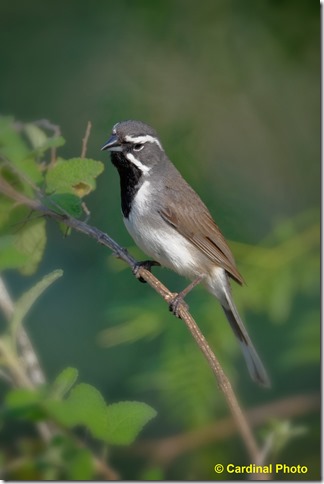
Black-throated Sparrows aren’t the most colorful bird in the Hill Country,
but they are still really cool looking!
Image from our Texas Hill Country photo safari.
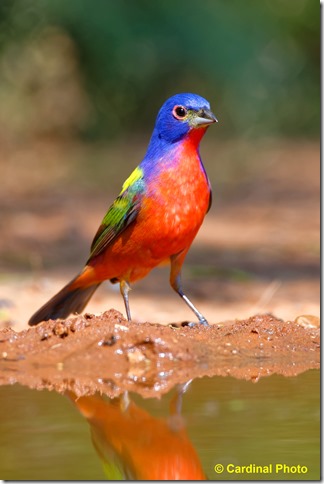
The Tamron did a great job of showing color,
like that of this Painted Bunting.
Summary: Should you buy one?
In short, if you are looking for a reasonably-priced lens for wildlife photography, this is the best model I’ve seen out there (pending my review of the Sigma version). This is especially true if you need the added reach of 600mm for bird photography, or for safaris where you are not able to get close to mammals (for example, in National Parks in Africa, where typically you can not off-road, or in the US, where there are often practical considerations that limit how close you can get). At $1069 at B&H for the Nikon, Canon, or Sony version, the lens is an incredibly-good value.
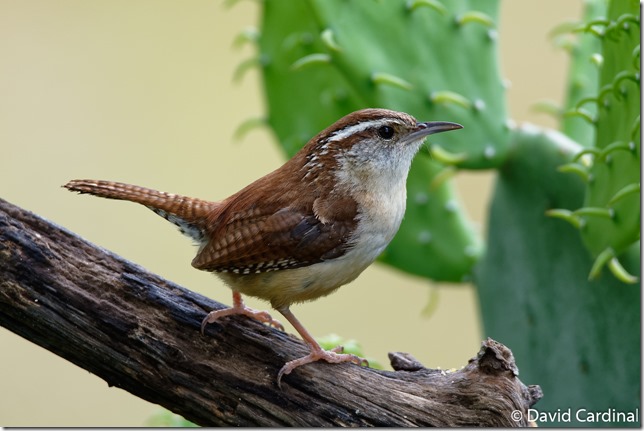
One great thing about having a zoom is that you can zoom out to help find small subjects in the lens,
then zoom in for tight shots like this Cactus Wren photographed at 600mm
- Log in to post comments


